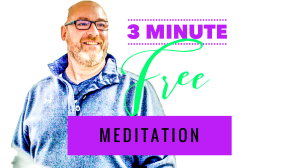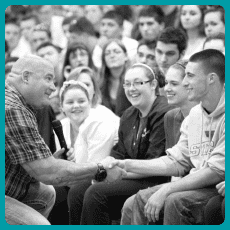TED Talk On Suicide
Teen Suicide is an epidemic today, teens are not reaching out to trusted adults for help and are afraid they’re going against their friends if they say something. Jeff helps you communicate to your teens. Suicide prevention for teens has never been more important than now.Teen Suicide & Mental Health – Taboo . . . Let’s not talk about it!
Imagine if and when we start doing mindfulness in our schools what a difference only 3 minutes per day will make? Here is a quick 3 minute mindfulness meditation for your class. It’s FREE. Use it whenever, wherever you’d like. CLICK HERE Not talking about it is safe and easy, but it’s wrong. Jeff enjoys talking about it because he knows we need to and it saves lives. Let Jeff make it interesting and eye-opening in a way where your audience will feel empowered to make a difference. We need your staff and community members to be able to intervene before a crisis will occur. Let’s talk about it
Not talking about it is safe and easy, but it’s wrong. Jeff enjoys talking about it because he knows we need to and it saves lives. Let Jeff make it interesting and eye-opening in a way where your audience will feel empowered to make a difference. We need your staff and community members to be able to intervene before a crisis will occur. Let’s talk about it
Suicide can be prevented!
Suicide is a serious public health problem that can de stroy family, friends, classmates, co-workers, communities, and teacher personnel. Suicide is a major problem for teens and our military personnel and veterans and Jeff Yalden is the expert teaching others how they can help to prevent suicide from happening. 90% of the time there are clues before a suicide is completed or attempted.
2011 is the most recent year in which full data is available. Suicide then accounted for 12 deaths for every 100,000 people nationwide, making it the country’s 10th leading cause of death. Unlike many other leading causes of death, suicide continues to claim more lives every year. Today, over 1 Million people die to suicide. Imagine 100 people per day or 1 person every 15 minutes. Staggering! These numbers are only climbing and we can make a difference when we know how to intervene and act accordingly. We can prevent suicides from happening within our communities.
Trying to uncover the reason for an individual suicide death is complex and challenging. What we do know from research is that 90% of people who die by suicide have a potentially treatable mental disorder at the time of their death – a disorder that often has gone unrecognized and untreated.
Jeff Yalden will help you understand the symptoms and the signs to look for. With a little bit of information we can easily reach those of our students or young people whom don’t know where to turn and we can be the ones that save their lives.
stroy family, friends, classmates, co-workers, communities, and teacher personnel. Suicide is a major problem for teens and our military personnel and veterans and Jeff Yalden is the expert teaching others how they can help to prevent suicide from happening. 90% of the time there are clues before a suicide is completed or attempted.
2011 is the most recent year in which full data is available. Suicide then accounted for 12 deaths for every 100,000 people nationwide, making it the country’s 10th leading cause of death. Unlike many other leading causes of death, suicide continues to claim more lives every year. Today, over 1 Million people die to suicide. Imagine 100 people per day or 1 person every 15 minutes. Staggering! These numbers are only climbing and we can make a difference when we know how to intervene and act accordingly. We can prevent suicides from happening within our communities.
Trying to uncover the reason for an individual suicide death is complex and challenging. What we do know from research is that 90% of people who die by suicide have a potentially treatable mental disorder at the time of their death – a disorder that often has gone unrecognized and untreated.
Jeff Yalden will help you understand the symptoms and the signs to look for. With a little bit of information we can easily reach those of our students or young people whom don’t know where to turn and we can be the ones that save their lives.
“I wanted to come and listen to your presentation with the 10th grade class (Hunter’s class) in the morning before we had to leave, but was not able to do that because I started crying the moment I woke up that day and I knew it would not stop as soon as I stepped foot into that school. I thought you should know that you are the speaker people and students are talking about so I am sincerely grateful and thankful that there are people like you doing what you do….making an impact and changing lives. I only wish is that we would have found you last year to come and speak at our school. Unfortunately it is my horrific tragedy that has sparked action by some community members (The Ripple Effect Group). Thank you for being an amazing human being and I hope that my Hunter was listening to you that day and smiling from heaven.” – Jennifer Wilder-Nordlof, Lost her son to Suicide – February 2017
Your Role In Suicide Prevention For Teens By Jeff Yalden, CSP, Suicide Prevention Expert
 Suicide is a a major concern that is invading schools and communities at an ever increasing rate and your school is not immune. Every day it is estimated that 85 individuals commit suicide in the United States alone and for every death by suicide there are 25 suicide attempts. Suicide has climbed to the third leading cause of death for youth ages 15-24 with ‘accidental deaths’ ranking second.
I deal with suicide and mental health weekly. It’s surprising when I talk to students, parents, faculty, staff members, and administrators, to hear they are often surprised when they hear how vulnerable their community is to depression and other mental health concerns. Suicide is taboo. Let’s not talk about it. 90% of suicides are a result of depression, a form of mental health. Suicide is preventable and there is HOPE.
The truth is that we are in a national, regional and personal war against suicide with our focus on not only saving lives but on ending stigma toward suicide and other mental health concerns. How are we supposed to prevent suicides when a majority of well educated professionals in leadership roles do not recognize that this problem exists right under their leadership, in their communities, in their schools?
Interpersonal research on suicidal communications among significant others has shown that one of the most common responses of friends and family members to a threat of suicide is no response even though, 90 percent of people thinking about taking their lives have communicated their intentions to others. If you suspected that a friend was suffering from pneumonia or a broken leg, you would most likely do something to intervene. Peoples’ response to a possible suicide crisis tends to be much more complicated, though it does not have to be. We have to stop being afraid to talk about the “S” word. You will learn this skill and many others in my suicide prevention workshop.
Most people have not been educated on the warning signs and symptoms of suicide and there fore do not know what to look for when anticipating whether someone they know is at risk for suicide. Most people do not know how to talk to someone about suicide and most people struggle with how to get help for someone that they feel could be at risk. One common myth about suicide is the thinking that if I talk to the person about suicide, I might make him or her feel worse, or worse yet, I might put the idea in his or her head. This myth is simply not true. In fact, most individuals who attempt or complete suicide are ambivalent about the act of taking their own life up until the point that they attempt or complete suicide. Most individuals want desperately to be helped and saved from the pain, but in feeling trapped or stuck begin to think that suicide may be the only option. Most suicidal individuals enter that point in which they actually intend to take their own lives only briefly until the state of crisis is over.
Suicide is a a major concern that is invading schools and communities at an ever increasing rate and your school is not immune. Every day it is estimated that 85 individuals commit suicide in the United States alone and for every death by suicide there are 25 suicide attempts. Suicide has climbed to the third leading cause of death for youth ages 15-24 with ‘accidental deaths’ ranking second.
I deal with suicide and mental health weekly. It’s surprising when I talk to students, parents, faculty, staff members, and administrators, to hear they are often surprised when they hear how vulnerable their community is to depression and other mental health concerns. Suicide is taboo. Let’s not talk about it. 90% of suicides are a result of depression, a form of mental health. Suicide is preventable and there is HOPE.
The truth is that we are in a national, regional and personal war against suicide with our focus on not only saving lives but on ending stigma toward suicide and other mental health concerns. How are we supposed to prevent suicides when a majority of well educated professionals in leadership roles do not recognize that this problem exists right under their leadership, in their communities, in their schools?
Interpersonal research on suicidal communications among significant others has shown that one of the most common responses of friends and family members to a threat of suicide is no response even though, 90 percent of people thinking about taking their lives have communicated their intentions to others. If you suspected that a friend was suffering from pneumonia or a broken leg, you would most likely do something to intervene. Peoples’ response to a possible suicide crisis tends to be much more complicated, though it does not have to be. We have to stop being afraid to talk about the “S” word. You will learn this skill and many others in my suicide prevention workshop.
Most people have not been educated on the warning signs and symptoms of suicide and there fore do not know what to look for when anticipating whether someone they know is at risk for suicide. Most people do not know how to talk to someone about suicide and most people struggle with how to get help for someone that they feel could be at risk. One common myth about suicide is the thinking that if I talk to the person about suicide, I might make him or her feel worse, or worse yet, I might put the idea in his or her head. This myth is simply not true. In fact, most individuals who attempt or complete suicide are ambivalent about the act of taking their own life up until the point that they attempt or complete suicide. Most individuals want desperately to be helped and saved from the pain, but in feeling trapped or stuck begin to think that suicide may be the only option. Most suicidal individuals enter that point in which they actually intend to take their own lives only briefly until the state of crisis is over.
 Suicide can be stopped with basic training in the a) warning signs, b) ways to talk to a suicidal individual, and c) places to refer him or her for immediate help. This is the training that I do in schools and communities through my teen suicide prevention presentation. I am on the front lines of suicide prevention, but it is essential that you educate yourself about the ways that you can help.
Suicide can be stopped with basic training in the a) warning signs, b) ways to talk to a suicidal individual, and c) places to refer him or her for immediate help. This is the training that I do in schools and communities through my teen suicide prevention presentation. I am on the front lines of suicide prevention, but it is essential that you educate yourself about the ways that you can help.

